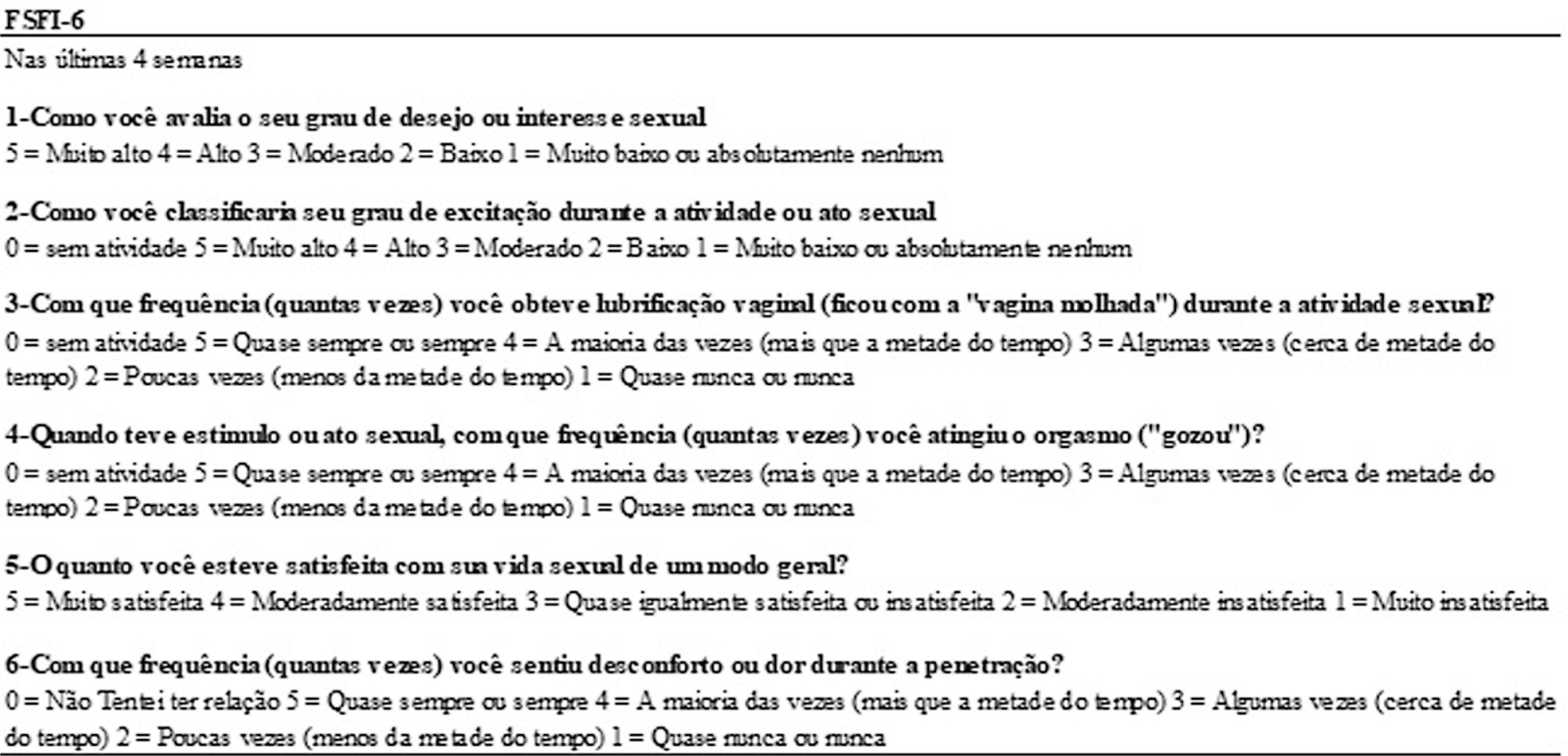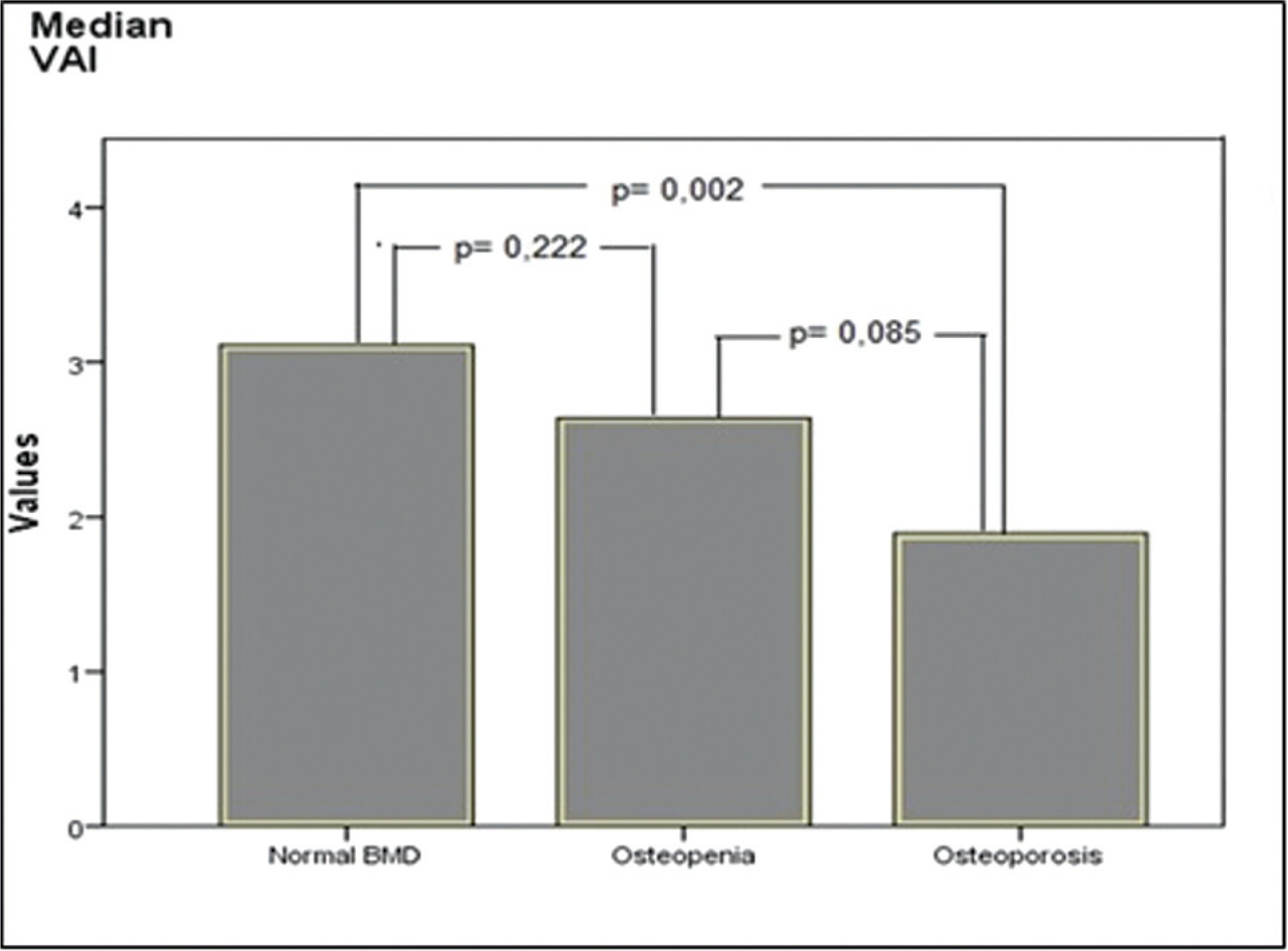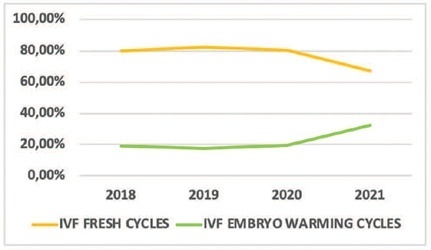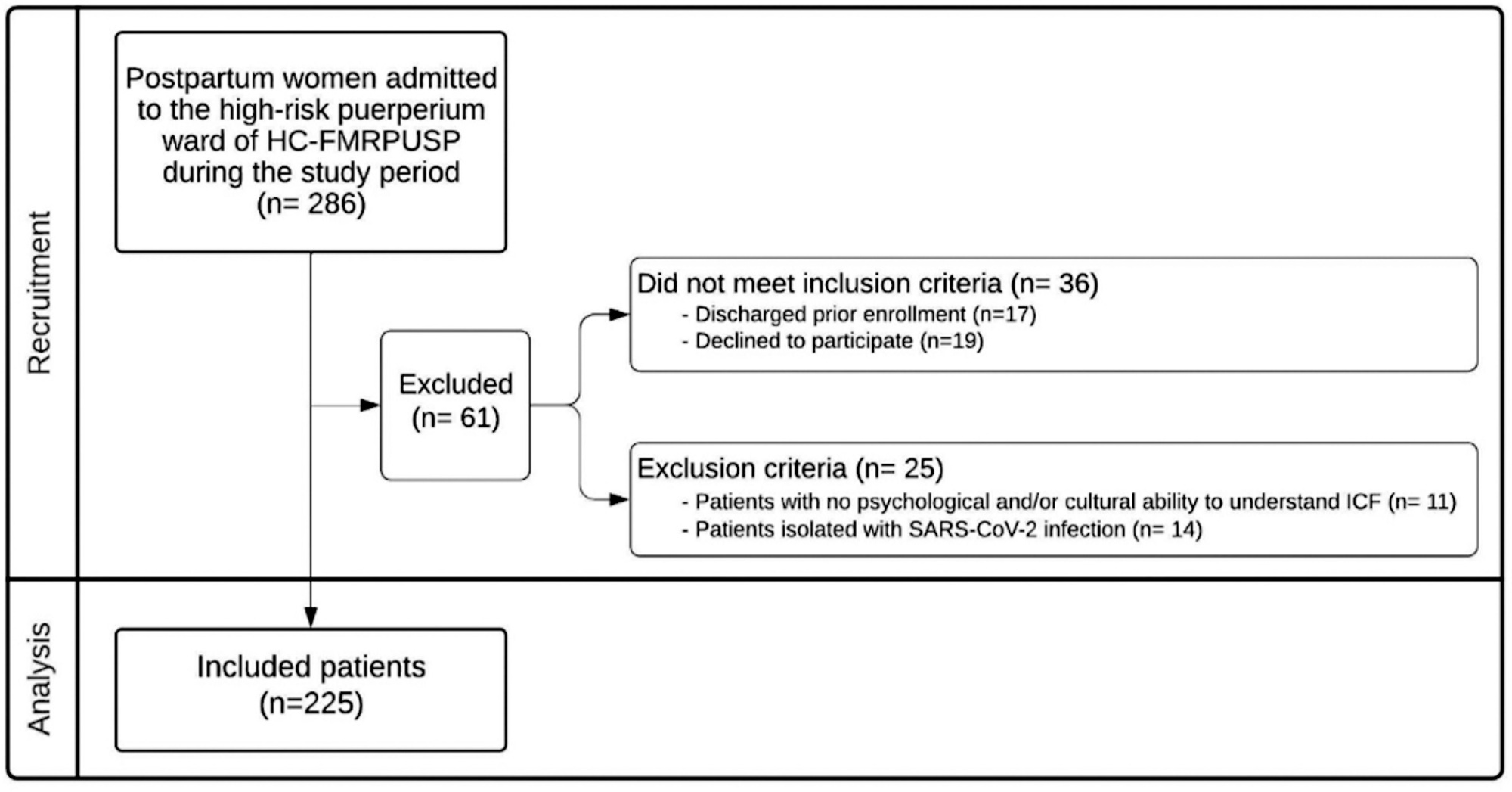Summary
Revista Brasileira de Ginecologia e Obstetrícia. 2023;45(2):089-095
We evaluated internal consistency, test-retest reliability, and criterion validity of the Brazilian Portuguese version of the Female Sexual Function Index 6-item Version (FSFI-6) for postpartum women.
Therefore, questionnaires were applied to 100 sexually active women in the postpartum period. The Cronbach α coefficient was used to evaluate the internal consistency. Test-retest reliability was analyzed by Kappa for each item of the questionnaire and by the Wilcoxon parametric test, comparing the total scores of each evaluation. For the assessment of criterion validity, the FSFI was used as the gold standard and the receiver operating characteristic (ROC) curve was constructed. Statistical analysis was performed using IBM SPSS Statistics for Windows, version 21.0 (IBM Corp., Armonk, NY, USA). It was found that the internal consistency of the FSFI-6 questionnaire was considerably high (0.839).
The test-retest reliability results were satisfactory. It can also be stated that the FSFI-6 questionnaire presented excellent discriminant validity (area under the curve [AUC] = 0.926). Women may be considered as having sexual dysfunction if the overall FSFI-6 score is < 21, with 85.5% sensitivity, 82.2% specificity, positive likelihood ratio of 4.81 and negative likelihood ratio of 0.18.
We conclude that the Brazilian Portuguese version of FSFI-6 is valid for use in postpartum women.

Summary
Revista Brasileira de Ginecologia e Obstetrícia. 2023;45(2):082-088
It was aimed to compare visceral adiposity index (VAI) levels in patients with normal bone mineral density (BMD), osteopenia, and osteoporosis.
One hundred twenty postmenopausal women (40 with normal BMD, 40 with osteopenia, and 40 with osteoporosis) between the ages of 50 to 70 years were included in the study. For females, the VAI was calculated using the formula (waist circumference [WC]/[36.58 + (1.89 x body mass index (BMI))]) x (1.52/High-density lipoprotein [HDL]-cholesterol [mmol/L]) x (triglyceride [TG]/0.81 [mmol/L]).
The time of menopause from the beginning was similar in all groups. Waist circumference was found to be higher in those with normal BMD than in the osteopenic and osteoporotic groups (p = 0.018 and p < 0.001, respectively), and it was also higher in the osteopenic group than in the osteoporotic group (p = 0.003). Height and body weight, BMI, blood pressure, insulin, glucose, HDL-cholesterol, and homeostasis model assessment-insulin resistance (HOMA-IR) levels were similar in all groups. Triglyceride levels were found to be higher in the normal BMD group, compared with the osteoporotic group (p = 0.005). The level of VAI was detected as higher in those with normal BMD, compared with the women with osteoporosis (p = 0.002). Additionally, the correlation analysis showed a positive correlation between dual-energy X-ray absorptiometry (DXA) spine T-scores, WC, VAI, and a negative correlation between DXA spine T-scores and age.
In our study, we found higher VAI levels in those with normal BMD, compared with women with osteoporosis. We consider that further studies with a larger sample size will be beneficial in elucidating the entity.

Summary
Revista Brasileira de Ginecologia e Obstetrícia. 2023;45(2):074-081
The present study evaluated the profile of germline mutations present in patients who underwent genetic counseling for risk assessment for breast cancer (BC), ovarian cancer (OC), and endometrial cancer (EC) with a possible hereditary pattern.
Medical records of 382 patients who underwent genetic counseling after signing an informed consent form were analyzed. A total of 55.76% of patients (213/382) were symptomatic (personal history of cancer), and 44.24% (169/382) were asymptomatic (absence of the disease). The variables analyzed were age, sex, place of birth, personal or family history of BC, OC, EC, as well as other types of cancer associated with hereditary syndromes. The Human Genome Variation Society (HGVS) nomenclature guidelines were used to name the variants, and their biological significance was determined by comparing 11 databases.
We identified 53 distinct mutations: 29 pathogenic variants, 13 variants of undetermined significance (VUS), and 11 benign. The most frequent mutations were BRCA1 c.470_471delCT, BRCA1 c.4675 + 1G > T, and BRCA2 c.2T> G. Furthermore, 21 variants appear to have been described for the first time in Brazil. In addition to BRCA1/2 mutations, variants in other genes related to hereditary syndromes that predispose to gynecological cancers were found.
This study allowed a deeper understanding of the main mutations identified in families in the state of Minas Gerais and demonstrates the need to assess the family history of non-gynecological cancer for risk assessment of BC, OC, and EC. Moreover, it is an effort that contributes to population studies to evaluate the cancer risk mutation profile in Brazil.

Summary
Revista Brasileira de Ginecologia e Obstetrícia. 2023;45(3):142-148
To understand the impact of the coronavirus disease 2019 pandemic on in vitro fertilization (IVF) clinical pregnancy rates and analyze factors that may have influenced their outcome.
This was a retrospective observational study conducted at a tertiary-care Brazilian fertility center. All fresh IVF and embryo warming cycles performed from March 11 to December 31, 2018–2021 were analyzed, and their data were used to calculate fertilization, embryo cleavage, cycle cancellation, embryo transfer (ET), and clinical pregnancy rates. Statistical tests were used to evaluate the alterations found. Logistic regression models were used to explore the association of the categorical variables with the observed clinical pregnancy rates. Data from 2018 and 2019 (prepandemic) and 2020 and 2021 (pandemic) were grouped.
A total of 756 cycles were analyzed (n = 360 prepandemic and n = 396 pandemic). The age group of the patients, fertilization rates, and cleavage rates did not have significant differences (p > 0.05). There was a reduction in the percentage of fresh IVF and an increase in embryo warming cycles (p = 0.005) during the pandemic. There was also an increase in fresh cycle cancellations (p < 0.001) and a reduction in ET rates (p < 0.001). The pandemic had a negative impact on clinical pregnancy rates (p < 0.001) especially due to the increase in fresh cycle cancellations (p < 0.001).
Embryo warming cycles with subsequent frozen-thawed ET were presented as a viable alternative to continue assisted reproductive treatments against pandemic restrictions on fresh cycles, ensuring clinical pregnancy, albeit at a lower rate than that of the prepandemic period.

Summary
Revista Brasileira de Ginecologia e Obstetrícia. 2023;45(2):065-073
The study was conducted to determine the quality of life and depression of women with gestational diabetes during pregnancy and the postpartum period.
100 pregnant women with gestational diabetes and 100 healthy pregnant women were included in the present study. Data were obtained from pregnant women in their third trimester who agreed to take part in the study. The data was collected during the third trimester and six to eight weeks after the baby was born. The data were obtained by socio-demographic characteristics form, postpartum data collection form, the MOS 36 Item Short Form Health Survey and Center for Epidemiologic Studies Depression Scale (CESD).
The mean age of pregnant women with gestational diabetes in the study was the same as the average age of healthy pregnant women. The CESD score of pregnant women with gestational diabetes was 26,77 ± 4,85 while the corresponding score was 25,19 ± 4,43 for healthy women. Additionally, the score in the postpartum period was 32.47 ± 5.94 for pregnant women with gestational diabetes and 35.47 ± 8.33 for healthy pregnant women. CESD scores were found to be higher than the cut-off score of 16 in both groups, and the mean scores increased during the postpartum period.
During the postpartum period, the quality of life of pregnant women with gestational diabetes was affected more negatively than healthy pregnant women. Depressive symptoms of women with both gestational diabetes and healthy pregnancy were found to be high in pregnancy and postpartum periods.
Summary
Revista Brasileira de Ginecologia e Obstetrícia. 2023;45(2):059-064
To evaluate the seroprevalence of toxoplasmosis among puerperal women cared for at a tertiary university hospital and the level of understanding of these puerperal women about toxoplasmosis, vertical transmission, and its prophylaxis.
For this cross-sectional study, we evaluated 225 patients using presential interviews, prenatal documentation, and electronic medical records. Data were stored using Research Electronic Data Capture (REDCap) software. Prevalence rates were estimated by the presence of reactive IgG antibodies against Toxoplasma gondii. Data analysis was performed using the chi-square test and calculation of the odds ratio (OR). Seroreactivity to T. gondii and exposure variables (age, educational level, and parity) were analyzed using a confidence interval (95%CI) and a significance level of 5% (p < 0.05).
The seropositivity rate for T. gondii was 40%. There was no association between seroprevalence and age. Primiparity was a protective factor against seropositivity and low education was a risk factor.
Knowledge of T. gondii infection and its transmission forms was significantly limited, presenting a risk for acute maternal toxoplasmosis and vertical transmission of this protozoan. Increasing the education level regarding the risk of toxoplasmosis during pregnancy could reduce the rates of infection and vertical transmission of this parasite.

Summary
Revista Brasileira de Ginecologia e Obstetrícia. 2023;45(3):127-133
To assess the maternal blood levels of fatty acids (FAs) in pregnancies with fetal growth restriction (FGR).
This prospective cross-sectional study included pregnant women with gestational age between 26 and 37 + 6 weeks with FGR and appropriate for gestational age (AGA) fetuses. The levels of saturated, trans, monounsaturated, and polyunsaturated FAs were measured using centrifugation and liquid chromatography. The Student’s t-test, Mann-Whitney test, and general linear model, with gestational age and maternal weight as covariants, were used to compare FA levels and the FGR and AGA groups. The Chi-square was used to evaluate the association between groups and studied variables.
Maternal blood sample was collected from 64 pregnant women, being 24 FGR and 40 AGA. A weak positive correlation was found between the palmitoleic acid level and maternal weight (r = 0.285, p = 0.036). A weak negative correlation was found between the gamma-linoleic acid level and gestational age (r = −0.277, p = 0.026). The median of the elaidic acid level (2.3 vs. 4.7ng/ml, p = 0.045) and gamma-linoleic acid (6.3 vs. 6.6ng/ml, p = 0.024) was significantly lower in the FGR than the AGA group. The palmitoleic acid level was significantly higher in the FGR than AGA group (50.5 vs. 47.6ng/ml, p = 0.033).
Pregnant women with FGR had lower elaidic acid and gamma-linoleic acid levels and higher palmitoleic acid levels than AGA fetuses.
Summary
Revista Brasileira de Ginecologia e Obstetrícia. 2023;45(4):201-206
To evaluate recurrence rates and risk factors among women with stage IA1 cervical cancer without lymph vascular space invasion managed conservatively.
retrospective review of women with stage IA1 squamous cervical cancer who underwent cold knife cone or loop electrosurgical excision procedure, between 1994 and 2015, at a gynecologic oncology center in Southern Brazil. Age at diagnosis, pre-conization findings, conization method, margin status, residual disease, recurrence and survival rates were collected and analyzed.
26 women diagnosed with stage IA1 squamous cervical cancer without lymphovascular space invasion underwent conservative management and had at least 12 months follow-up. The mean follow-up was 44.6 months. The mean age at diagnosis was 40.9 years. Median first intercourse occurred at age 16 years, 11.5% were nulliparous and 30.8% were current or past tobacco smokers. There was one Human immunodeficiency virus positive patient diagnosed with cervical intraepithelial neoplasia grade 2 at 30 months after surgery. However, there were no patients diagnosed with recurrent invasive cervical cancer and there were no deaths due to cervical cancer or other causes in the cohort.
Excellent outcomes were noted in women with stage IA1 cervical cancer without lymphovascular space invasion and with negative margins who were managed conservatively, even in a developing country.